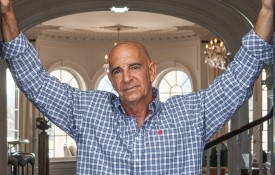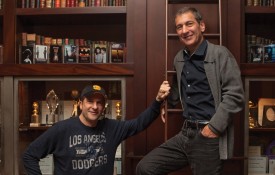Dr. Gary Michelson loves to be disruptive. Not in a boisterously pejorative manner that leads to disarray and confusion. Michelson is disruptive in an inquisitively intuitive manner that seeks to solve problems.
From his surgical inventions that redefined the methods of spinal surgery, to his successful billion dollar patent-ownership lawsuit against medical device conglomerate Medtronic, to his $100 million philanthropic efforts that fund his Medical Research Foundation, 20 Million Minds, and Found Animals, Michelson has sought to disrupt common truths, upend the status quo, and change the world for the better.
Michelson, 64, is a striking person, physically and mentally. He is as fit as a man 20 years his junior and is not only the sole patent holder of more than 900 medical and surgical procedures and devices, but has hands that are unusually large and wide for a man who is just over six feet tall. His “lobster claws” as Michelson calls them are somewhat of a legend in local circles. Decades ago, while playing beach volleyball in Santa Monica, former Lakers Center Wilt Chamberlain, a regular beach volleyball player, was bragging that his hands were so big he could palm his 16-pound bowling ball. Michelson stepped up to challenge the seven-footer, winning a bet after he showed the NBA Hall-of-Famer that he, too, could palm the bowling ball.
Over the years Michelson created more than 900 surgical instruments and procedures that he patented and amassed a fortune of $300 million, according to Forbes.
Michelson’s intellect, storytelling, and philanthropy make him a cross between Siri, Gene Roddenberry, and Robin Hood. His mind is a server unto itself; the information he shares is so vast, one’s head spins trying to visualize the details with which his philanthropic efforts are focused: advancing affordable higher education with online textbooks, vacinations against parasitic worms, RNA interference, cost-effective animal infertility/adoption programs, and the science involved with each topic. Often, he’ll translate his knowledge into layman’s terms through analogous stories plucked from classic Star Trek episodes that vividly illustrate his point.
Sitting in the living room of his Brentwood Canyon home, Michelson tells of the destruction
parasitic worms are wreaking on billions of people, many of whom are children in poor countries. “There’s at a minimum 1.7 billion people on earth – The World Health Organization says 3 billion – who are being eaten from inside out by parasitic worms. They are generally people of color and they are by far the poorest people on the earth.”
Michelson learned about the epidemic of parasitic worms from a story in a national news magazine. It detailed The Sabin Vaccine Institute’s effort to create a vaccine that will eradicate hookworms, roundworms, whipworms, and schistosomiasis parasites. Parasitic worms, after entering a body, live off of the host’s blood. They are the number one cause, in third-world countries, of women dying during childbirth because the birth mothers are anemic due to their weakened blood. Parasitic worms often enter children’s bodies by burrowing into their bare feet and as they feast off their blood and diminish blood circulation they stunt the body’s growth and disrupt a child’s ability to concentrate.

Photo: Sevan Pulurian
“The little kids with the blown-up bellies that you see on TV – those kids are basically starving to death because [parasitic] worms are eating everything that comes into them,” says Michelson. He has seen cases where surgeons have removed an entire quart of worms from a child’s abdomen.
Through his $100 million medical foundation, Michelson has donated millions to The Sabin Institute not only because of the organization’s cause, but because of its methods. They are disruptive – creating new technology that seeks to circumvent common conceptions. The Sabin Institute’s vaccine will kill the entire worm, Michelson emphasizes — as opposed to typical vaccines that attack only a viral particle or a particular bacteria.
Michelson’s constant search for research that upsets the status quo led him to fund research into messenger RNA interference years before the National Institutes of Health considered it worth funding, he says.
“[I]n trying … to make cats and dogs infertile, we’re now actually learning how you can signal the opposite in other mammals, such as humans, and make people who are infertile, fertile.”
He sees the research as being an integral part of his effort to create an injectable method to spay and neuter cats and dogs at no and low cost. Michelson’s Found Animals Foundation supports clinics that spay and neuter dogs and cats, runs a mobile unit in south Los Angeles, and a free microchip program that helps owners recover lost pets. To achieve the development of a sterilization injection, he created a $25-million prize and additional $50 million in grants, according to the New York Times.
Every year in the United States, up to 4 million adoptable cats and dogs are killed in shelters; 25 percent of those animals are purebred. It is not unusual to find Michelson visiting an animal shelter. He remembers one time a woman dropped off a pair of Harlequin Great Danes, for which she said she paid $3,500 each. On her way to vacation in Europe for months, the shelter was her only option to house the animals. After she left, the shelter’s attendant told Michelson the Great Danes would eventually be euthanized, because he didn’t expect anyone to come to the shelter looking for purebred dogs, and large dogs do not do well, either. “Meanwhile, 10 million cats and dog are bought every year from pet stores and breeders,” says Michelson.
“We offered this prize for finding a single-dose sterilizer for cats and dogs because I knew there was no ongoing research in this area, so researchers would have to be lured from other areas,” says Michelson.
And Michelson’s research into a single-dose infertility shot for cats and dogs led his researchers to what can be considered the nuclear disruptive button: “We didn’t intend for there to be any human application to this, but in trying to learn how to make cats and dogs infertile, we’re now actually learning how you can signal the opposite in other mammals, such as humans, and make people who are infertile, fertile.
“Everything we do has an element of being disruptive or different from what other people are doing,” he says.
Michelson is disrupting higher education with his 20 Million Minds foundation. The nonprofit organization’s goal is to support the creation of digital textbooks that are “open licensed” and provide online editing capabilities to professors. “The status quo has created a higher educational system that supports economic hierarchy making it nearly financially unfeasible for poor students to afford college,” says Michelson.
Michelson, who has described himself as at first being an indifferent college student, says his grandmother set him on his path to becoming a doctor, or a “person,” early on in his life. “In Judaism, it is held that a fetus does not become a person until they graduate from medical school,” says Michelson with a laugh.
His grandmother suffered from cysts that formed in her spinal cord. The disease, Syringomyelia, often leads to progressive weakness in the arms and legs, stiffness in the back, shoulders and chronic, severe pain. Also, the cysts injure nerve fibers that carry information from the brain to the extremities. Often, people with Syringomyelia cannot feel pain in their hands and feet.
Michelson remembers a day during his childhood when his grandmother was cooking in the kitchen. Her hand got too close to the oven burner and caught on fire. She didn’t feel the fire burning her. Michelson smelled the fire and saw his grandma’s hand burning. He helped her douse the flames, but that image remained etched in his mind.
“She said, ‘Oh you’ll be a back doctor and you’ll fix me,’” Michelson remembers and with that she set his life’s goal. “If you go back, a lot of what you are right now seems to be predetermined from things that happened in your childhood.”
Once Michelson graduated medical school, he told his professors he wanted to go into spinal surgery and they suggested he choose another focus. They reasoned that he would sentence himself to a career of unhappy patients. “You’ll have to move to another city every couple of years,” they said to Michelson, who saw an opportunity to make spinal surgery better.
Michelson is a surgeon who hates the sight of blood, so he was known to have clean operating rooms and make small incisions. Because his hands are so large, he had trouble seeing inside patients’ bodies and maneuvering surgical tools. After designing new tools at home he hired a machinist to create them. Over the years Michelson created more than 900 surgical instruments and procedures that he patented and amassed a fortune of $300 million, according to Forbes.
“In Judaism, it is held that a fetus does not become a person until they graduate from medical school.”
Michelson became a wealthy man after medical device company Medtronic bought his largest licensing client. The medical tech giant soon sued Michelson, claiming he had marketed his products to other manufacturers, violating their contract.
“One guy who worked at Medtronic thought he would show off and teach other people how you do a deal. And you do a deal by creating leverage you don’t really have,” says Michelson, tracing the origin of the Medtronic lawsuit. “Then, to his amazement, it started to backfire on him and … they [Medtronic] just started to get deeper and deeper.”
Michelson spent $62 million on 36 attorneys, according to Forbes, and in the end was victorious. The court awarded him $510 million, and in a negotiated deal, Medtronic agreed to pay Michelson $1.35 billion, a record agreement, so he would not pull his patents.
Following his settlement, Michelson turned his focus to his philanthropic endeavors. His Brentwood home, nestled in the hills, is modest by billionaire-inventor standards. He enjoys populating his home with a combination of whimsical and mechanistic art pieces. He is not a “gadget guy,” lives sans cell phone, and has never named one of his inventions after himself, choosing rather to invent and then let the invention go.
“If you want to own it like that, then it’s going to own you,” says Michelson. “Nobody needs to have their name up in lights and there is no forever.”
Besides his philanthropic organizations, Michelson is focused on his family. He remarried a few years ago, and has a four-year-old daughter and a newborn son – he’s created a whole new family at 64 years old.
“I used to work all day,” says Michelson, who for years did not own a television because he did not want to be distracted from work. “I have nothing but respect for young parents but I couldn’t have done it – I was too selfish and too self-centered … you can’t say to your daughter, ‘Not now honey, I’m too busy.’”
Michelson is making sure his home is an oasis of peace while his philanthropic efforts disrupt the status quo outside. He just wants to be remembered as making a difference in the world.
“If I changed the world and I leave it better than I found and people say, ‘He made a difference,’ then that’s as good as it gets. You can only do so much.”













































